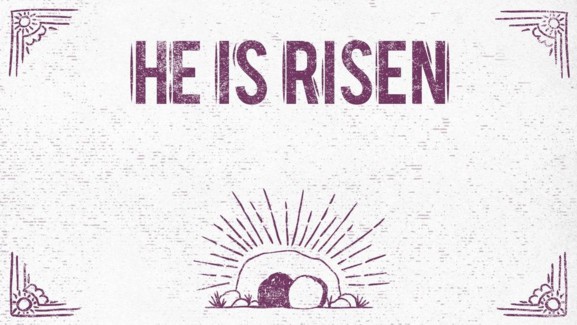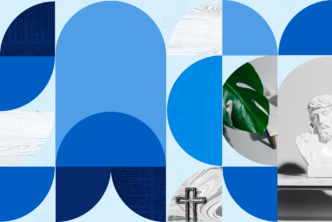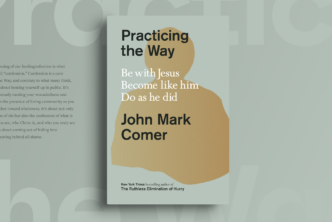In a culture that doesn’t sacrifice animals on altars when we make mistakes, it’s sometimes tough to explain how and why Jesus’ death on the cross atones for our sins. Without a system for understanding sin, sacrifice, and repentance, something doesn’t quite add up.
Sometimes when sharing the gospel we want to cut to the chase—Jesus rose from the dead and offers us eternal life. But to understand the significance of that world-changing event, people have to understand how sin hijacks our relationship with God, and how Jesus’ death restores that relationship.
You might’ve delved into defining sin and explaining our need for a savior on Good Friday or Ash Wednesday, but chances are you’re also expecting a lot of new people on Easter. Your Easter service is special—it may be the only sermon some people hear until Christmas—and because of that, your sermon may bear the burden of explaining the entire gospel from the beginning.
Metaphors and analogies always have flaws—if they didn’t, they actually wouldn’t be metaphors or analogies. We’d have to say things like, “God is like God.” But a carefully-crafted illustration could be what someone needs to make sense of a biblical explanation. Illustrations translate tough concepts by presenting them in simpler contexts.
As a youth leader for kids with little or no church background, I constantly use illustrations to supplement my explanations of the gospel. Here are three illustrations I’ve seen work well to help people understand sin.
These are by no means the best illustrations, nor should these be used as a substitute for Scripture.
Jesus picks up the check
Imagine you’re enjoying dinner at a restaurant with your friends. Some people are having a great time and ordering everything the menu has to offer, even though you know the menu is overselling the pros and disguising the cons of each item. Dangerous quantities of fat and grease make the food “juicy.” The taste promises to “give your life meaning.” Some of the food is delicious and some of it is disgusting, but it’s all bad for you, so some people choose to just have water. Everyone else falls somewhere between feasting and fasting. When the meal is finished, everyone gets their checks, and everyone’s bill is the same.
The cost of that one meal—even if you just had water—is one life.
Jesus puts our bill on his tab. Everything we ordered goes on his tab, and if we accept his offer, we don’t have to pay a thing. But here’s the catch: you can still refuse to let him pick up your tab. We can ignore his offer and cling to our checks out of pride, ignorance, or guilt. His hand is outstretched to take our check, and all we have to do is give it to him; and let him pay the price.
At first it might seem like God tricked us—why did he put us in this restaurant and hand us these menus if they were going to cost us our lives?
It’s not God’s restaurant, and he didn’t sell you anything. It’s under someone else’s management, and he’s a very good salesman (Ephesians 2:2, John 12:31).
Sin contaminates us
This is a pretty commonly used illustration, but it’s a powerful visual so I’m including it. For this you’ll need a clear pitcher, two clear cups, an eyedropper, iodine, water, and bleach.
Fill the pitcher with water. This represents God. Pour some of the water from the pitcher into a cup—this cup represents us. Humans were made to be in relationship with God—God with us (as the water pours from the pitcher into the cup) and us with God (as the water pours from cup to pitcher).
Fill an eyedropper or another cup with iodine. This represents sin. Pour some iodine into the cup that represents us. If you add a lot, the water changes color, but whether the change is visible is not the theological point. Even if you use the eyedropper to put in “just a little bit” of sin, the water is contaminated. You can’t pour the iodine-water back into the pitcher without getting iodine in the pitcher. Likewise, our sin does not belong in a relationship with God (Psalm 5:4, Psalm 92:15, 1 John 1:6, Isaiah 59:2).
This is where Jesus comes in. Fill the second cup with bleach to represent Jesus. Pour some of the bleach into the cup that represents us. The bleach reacts with the iodine and turns the contents of the cup clear again, showing how Jesus cleanses us of our sin. You can also pour the remaining iodine into the cup representing Jesus, to show how Jesus took all our sin upon himself (the iodine becomes clear when it touches the bleach). Because Jesus cleanses us from sin, we are free to enter into a relationship with God again.
This is also pretty easy to pull off without the pitcher, if you prefer to emphasize Jesus’ role in the process and his victory over sin.
We choose sin instead of righteousness
This one is often done a couple of different ways, but the basic principle is the same. Take two chairs and put a person in each one, facing each other. One person represents God and the other represents us.
The person who represents us turns their chair away from God. You could put something behind him or her that is “more appealing” than God to represent sin (money, a computer, TV, phone, etc.). Now give them headphones and sunglasses, so that even if they decided to turn around, they still couldn’t see or hear God.
Jesus removes our headphones, our sunglasses, and anything else that prevents us from being in relationship with God, but we still have to choose to turn our chair around.
Simplified version: use a garbage can to represent sin and place it between the two chairs. Whether the can is full or almost empty, our sin is in the way of our relationship with God.
Illustrations on sin from the Bible
The wages of sin:
Romans 6:23 tells us that the wages of sin is death. We work for our wages. You earn your paycheck for doing your job. And the paycheck sin earns is death. Every time. We are not the victims of our circumstances—if we do not choose life with Christ, then we are actively working towards death.
Our belief is credited to us as righteousness:
Romans 4 explains that Abraham’s belief was credited to him as righteousness, and in the same way, our belief in Jesus is credited to us as righteousness (Romans 4:23–24). Even though we ourselves are unrighteous, it is our belief in the one who is righteous that God credits to us as righteousness.
Share your sermons like a professional
Your sermons deserve to look as good as they sound. Proclaim Church Presentation Software lets anyone on your staff look like a professional with thousands of pieces of customizable church media, all produced by our graphic designers. You’ll save hours each week putting together your service, so you have more time to focus on what matters most.
Watch the video on this page to see what Proclaim can do for you, and then try it absolutely free for 30 days—no credit card required.








